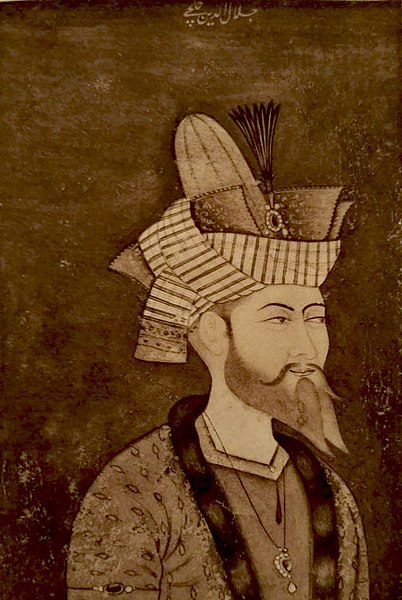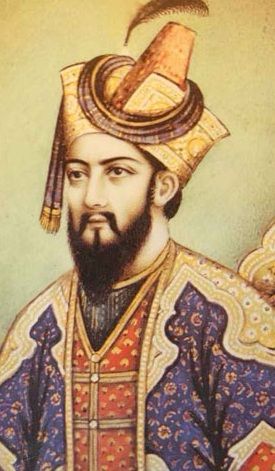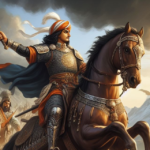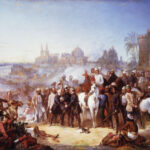The Khilji dynasty, also known as the Khalji dynasty, was a medieval Muslim dynasty that ruled over the Delhi Sultanate in India from 1290 to 1320. It was founded by Jalaluddin Khilji, who overthrew the last ruler of the Slave dynasty. The dynasty marked a significant shift in the political landscape of India and had a lasting impact on the history of the Delhi Sultanate.
Under the Khilji rulers, the Delhi Sultanate experienced a period of military expansion and political consolidation. The most notable and influential king of the Khilji dynasty was Alauddin Khilji, who ascended the throne in 1296. Alauddin embarked on ambitious military campaigns and successfully expanded the empire’s territories, including the conquest of Gujarat and parts of southern India.
The Khilji dynasty is often remembered for its military prowess and administrative reforms. Alauddin Khilji implemented various measures to strengthen the empire’s economy and governance. He introduced market regulations, standardized weights and measures, and implemented land reforms aimed at increasing revenue and centralizing power.
However, the Khilji dynasty faced internal conflicts and challenges towards the end of its rule. After Alauddin’s death in 1316, the dynasty saw a period of instability and power struggles. It ultimately came to an end in 1320 with the assassination of the last Khilji ruler, Qutbuddin Mubarak Shah.
The Khilji dynasty’s rule left a lasting impact on the political, social, and cultural landscape of medieval India. Its military achievements, administrative reforms, and architectural contributions shaped the subsequent history of the Delhi Sultanate and influenced the region’s historical development.
Jalaluddin Khilji (1290-1296)
Jalaluddin Khilji was the founder and first ruler of the Khilji dynasty in the Delhi Sultanate. He ascended to the throne in 1290 after overthrowing the last ruler of the Slave dynasty. Jalaluddin rose to prominence through his military skills and leadership in the Delhi Sultanate’s army.
As a ruler, Jalaluddin Khilji prioritized maintaining peace and stability within his kingdom. He pursued a policy of reconciliation and tolerance towards different factions and religious groups, aiming to foster unity and harmony. His peaceful approach allowed him to consolidate the empire and focus on internal affairs rather than engaging in extensive military campaigns.
Jalaluddin implemented economic reforms to promote prosperity and stability. He focused on improving trade, agriculture, and revenue collection to ensure the well-being of his subjects. Additionally, he patronized scholars, poets, and artists, fostering a cultural and intellectual atmosphere during his reign.
One notable aspect of Jalaluddin Khilji’s rule was his relationship with the Mongols. He established friendly relations with them and even married his daughter to a Mongol prince, aiming to ensure peace and stability on the northern frontier of his empire.
Jalaluddin survived an assassination attempt early in his reign, which further reinforced his commitment to maintaining stability and unity within the empire. However, his rule was relatively short-lived, as he was succeeded by his nephew and son-in-law, Alauddin Khilji, who went on to become one of the most prominent rulers of the Khilji dynasty.
Jalaluddin Khilji’s reign laid the foundation for the Khilji dynasty and set the tone for its early years. His focus on peace, stability, and economic reforms contributed to the growth and consolidation of the Delhi Sultanate under the Khilji rule.
Allaudin Khilji (1296-1316)
- Ascension to the Throne: Alauddin Khilji became the second ruler of the Khilji dynasty in the Delhi Sultanate after succeeding his uncle, Jalaluddin Khilji, in 1296.
- Military Conquests: Alauddin Khilji was known for his military prowess and conducted several successful military campaigns, expanding the boundaries of the Delhi Sultanate.
- Conquest of Gujarat: One of his major military achievements was the conquest of Gujarat in 1299, which added significant territory to the empire.
- Campaigns in Southern India: Alauddin Khilji led expeditions into the Deccan region, capturing and annexing territories such as Devagiri (Daulatabad) and Warangal.
- Reorganization of the Army: He reorganized the army, creating a standing army called the “New Order” (Diwan-i-Arz), which strengthened the military capabilities of the empire.
- Administrative Reforms: Alauddin Khilji implemented several administrative reforms, including the establishment of a powerful intelligence network, price controls, and market regulations.
- Land Revenue Reforms: He introduced the “Ghiyas-ud-din Tughlaq’s Revenue System,” which aimed to enhance revenue collection by imposing higher taxes on agricultural lands.
- Market Control: Alauddin Khilji implemented stringent market regulations to stabilize prices, control hoarding, and ensure the availability of essential commodities.
- Expansion of the State Machinery: He expanded the state machinery by creating new administrative departments, such as the Diwan-i-Risalat (Department of Correspondence) and Diwan-i-Insha (Department of Public Correspondence).
- Construction Projects: Alauddin Khilji undertook several construction projects, including the construction of the Alai Darwaza, which served as the entrance to the Qutub Minar complex.
- Centralization of Power: He concentrated power in his own hands and curtailed the influence of the nobility to maintain a strong and centralized rule.
- Control over Nobility: Alauddin Khilji exercised strict control over the nobility, implementing measures to prevent their accumulation of wealth and power.
- Policy of Terror: He adopted a policy of terror to instill fear and maintain discipline within his administration and the society at large.
- Intelligence Network: Alauddin Khilji established a robust intelligence network known as the “Barid-i-Mamalik,” which kept him informed about various internal and external matters.
- Famine Relief Measures: During times of famine, Alauddin Khilji implemented relief measures, including distribution of grains and establishing grain storage facilities.
- Patronage of Literature and Arts: Despite his stern rule, Alauddin Khilji patronized scholars, poets, and artists, contributing to the cultural development of the empire.
- Coinage Reforms: He introduced a new currency system, issuing a standardized coinage known as the “Tanka” to improve economic stability and facilitate trade.
- Embassy to China: Alauddin Khilji sent an embassy to China, strengthening diplomatic ties and facilitating trade between the two regions.
- Focus on Internal Security: He paid significant attention to internal security, strengthening border defenses and maintaining law and order within the empire.
- Naval Expeditions: Alauddin Khilji launched naval expeditions against the Yadava kingdom, strengthening the empire’s control over maritime trade routes.
- Control over Mongols: Alauddin Khilji skillfully defended the Delhi Sultanate against Mongol invasions, employing strategic military tactics and alliances to repel their advances and maintain the integrity of the empire’s borders. His successful defense ensured the security and stability of the Delhi Sultanate against external threats.
- Reorganization of the Revenue Department: Alauddin Khilji established the “Diwan-i-Mustakhraj” to monitor and assess the revenue collection process, ensuring efficient tax administration.
- Focus on Public Welfare: Despite his authoritarian rule, Alauddin Khilji implemented measures to promote public welfare, such as providing free medical treatment to the poor and establishing hospitals and dispensaries.
- Protection of Women: He implemented strict laws and regulations to protect the honor and safety of women, imposing severe punishments for crimes such as rape and harassment.
- Legacy: Alauddin Khilji’s rule left a significant impact on the Delhi Sultanate. His administrative and military reforms contributed to the empire’s stability and expansion, while his economic policies and market regulations aimed to ensure social welfare and control over the nobility. Although his methods were harsh, his rule shaped the subsequent history of the Delhi Sultanate and influenced future rulers.
Qutubddin Mubarak Shah
Qutbuddin Mubarak Shah was the last ruler of the Khilji dynasty in the Delhi Sultanate, reigning from 1316 to 1320. Here are some key points about his rule:
- Succession: Qutbuddin Mubarak Shah succeeded his predecessor, Alauddin Khilji, following his death in 1316.
- Short Reign: His reign was relatively short, lasting only four years.
- Internal Struggles: Qutbuddin Mubarak Shah faced internal conflicts and power struggles during his rule, which contributed to the decline and instability of the Khilji dynasty.
- Assassination: His reign ended with his assassination in 1320, marking the end of the Khilji dynasty’s rule.
- Weak Administration: Qutbuddin Mubarak Shah’s rule was marked by a weak administration and a lack of effective governance, leading to political unrest and a decline in the empire’s power.
- Regional Revolts: During his reign, several regional revolts and rebellions emerged, further weakening the empire’s control over its territories.
- Mongol Threat: The Mongols continued to pose a threat during his rule, and the Delhi Sultanate faced challenges in defending its borders against their incursions.
- Economic Challenges: The empire faced economic challenges during Qutbuddin Mubarak Shah’s reign, including inflation and a decline in revenue collection.
- Cultural and Literary Patronage: Despite the political instability, Qutbuddin Mubarak Shah continued to patronize scholars, poets, and artists, supporting the cultural and literary development of the time.
- Transition to Tughlaq Dynasty: Qutbuddin Mubarak Shah’s assassination marked the end of the Khilji dynasty’s rule and paved the way for the rise of the Tughlaq dynasty in the Delhi Sultanate.
Overall, Qutbuddin Mubarak Shah’s reign was marked by internal conflicts, political instability, and economic challenges, contributing to the decline and eventual downfall of the Khilji dynasty.
Multiple Choice Question

- Who was the founder of the Khilji dynasty?
a) Alauddin Khilji
b) Jalaluddin Khilji
c) Ghiyasuddin Khilji
d) Qutbuddin Khilji
Correct answer: b) Jalaluddin Khilji - Which of the following rulers of the Khilji dynasty was known for his market reforms?
a) Alauddin Khilji
b) Jalaluddin Khilji
c) Ghiyasuddin Khilji
d) Qutbuddin Khilji
Correct answer: a) Alauddin Khilji - Alauddin Khilji introduced a system of measurement called the _.
a) Dagh system
b) Ilahi calendar
c) Gaz system
d) Firuz Shahi coinage
Correct answer: a) Dagh system - The famous Alai Darwaza, located in Delhi, was built by which Khilji ruler?
a) Jalaluddin Khilji
b) Alauddin Khilji
c) Ghiyasuddin Khilji
d) Qutbuddin Khilji
Correct answer: b) Alauddin Khilji - Which Khilji ruler was known for his military campaigns against the Mongols?
a) Jalaluddin Khilji
b) Alauddin Khilji
c) Ghiyasuddin Khilji
d) Qutbuddin Khilji
Correct answer: a) Jalaluddin Khilji - Alauddin Khilji’s market control measures were primarily aimed at regulating the prices of _.
a) Food grains
b) Textiles
c) Gems and jewelry
d) Weapons
Correct answer: a) Food grains - The famous historian Amir Khusrau was associated with which Khilji ruler?
a) Jalaluddin Khilji
b) Alauddin Khilji
c) Ghiyasuddin Khilji
d) Qutbuddin Khilji
Correct answer: b) Alauddin Khilji - The construction of the famous Qutub Minar was completed during the reign of which Khilji ruler?
a) Jalaluddin Khilji
b) Alauddin Khilji
c) Ghiyasuddin Khilji
d) Qutbuddin Khilji
Correct answer: d) Qutbuddin Khilji - The Khalji dynasty originated from which region?
a) Afghanistan
b) Persia
c) Central Asia
d) Bengal
Correct answer: c) Central Asia - The Khilji dynasty ruled over which part of the Indian subcontinent?
a) North India
b) South India
c) Eastern India
d) Western India
Correct answer: a) North India
- Who among the following was the first Muslim ruler to establish his authority over the whole of India?
a) Jalaluddin Khilji
b) Alauddin Khilji
c) Ghiyasuddin Khilji
d) Qutbuddin Khilji
Correct answer: b) Alauddin Khilji - The capital of the Khilji dynasty was shifted from Delhi to which city?
a) Agra
b) Lahore
c) Jaipur
d) Daulatabad
Correct answer: d) Daulatabad - Alauddin Khilji’s famous market control measures included fixing the prices of various commodities through a system known as _.
a) Batai system
b) Barter system
c) Taxation system
d) Price control system
Correct answer: a) Batai system - Who was the wife of Alauddin Khilji who played a significant role in his administration?
a) Raziya Sultan
b) Chand Bibi
c) Jahanara Begum
d) Malik Kafur
Correct answer: d) Malik Kafur - The Khilji dynasty came to power after overthrowing the _ dynasty.
a) Slave
b) Tughlaq
c) Lodhi
d) Sayyid
Correct answer: a) Slave - Which Khilji ruler introduced the system of token currency?
a) Jalaluddin Khilji
b) Alauddin Khilji
c) Ghiyasuddin Khilji
d) Qutbuddin Khilji
Correct answer: b) Alauddin Khilji - The famous Koh-i-Noor diamond was acquired by Alauddin Khilji from the ruler of which kingdom?
a) Vijayanagara
b) Mewar
c) Malwa
d) Kakatiya
Correct answer: d) Kakatiya - The Khilji dynasty was known for its patronage of which art form?
a) Painting
b) Sculpture
c) Architecture
d) Music
Correct answer: c) Architecture - The Khilji dynasty was succeeded by which dynasty in India?
a) Mughal
b) Lodhi
c) Sayyid
d) Tughlaq
Correct answer: d) Tughlaq - Which Khilji ruler introduced the practice of “Mongol Chalisa”?
a) Jalaluddin Khilji
b) Alauddin Khilji
c) Ghiyasuddin Khilji
d) Qutbuddin Khilji
Correct answer: a) Jalaluddin Khilji - The Khilji dynasty was known for its expansionist policies. Which region did they conquer during their rule?
a) Deccan
b) Rajasthan
c) Bengal
d) Punjab
Correct answer: a) Deccan - Alauddin Khilji’s market reforms were primarily aimed at strengthening the _.
a) Economy
b) Military
c) Social structure
d) Religious institutions
Correct answer: b) Military
- The construction of the famous Alai Minar was started by which Khilji ruler?
a) Jalaluddin Khilji
b) Alauddin Khilji
c) Ghiyasuddin Khilji
d) Qutbuddin Khilji
Correct answer: c) Ghiyasuddin Khilji - Which Khilji ruler introduced the practice of recording the daily proceedings of the court in a document called “Diwan-i-Insha”?
a) Jalaluddin Khilji
b) Alauddin Khilji
c) Ghiyasuddin Khilji
d) Qutbuddin Khilji
Correct answer: d) Qutbuddin Khilji - The Khilji dynasty witnessed the invasion of India by the Mongols under the leadership of _.
a) Genghis Khan
b) Timur
c) Babur
d) Chengiz Khan
Correct answer: b) Timur - Which Khilji ruler was known for his efficient spy network and intelligence gathering system?
a) Jalaluddin Khilji
b) Alauddin Khilji
c) Ghiyasuddin Khilji
d) Qutbuddin Khilji
Correct answer: b) Alauddin Khilji - The Khilji dynasty ruled over Delhi Sultanate for a period of approximately _ years.
a) 50
b) 100
c) 150
d) 200
Correct answer: c) 150 - Who among the following Khilji rulers was assassinated by his own slave generals?
a) Jalaluddin Khilji
b) Alauddin Khilji
c) Ghiyasuddin Khilji
d) Qutbuddin Khilji
Correct answer: a) Jalaluddin Khilji - Alauddin Khilji’s market control measures included the establishment of a department known as _.
a) Diwan-i-Riyasat
b) Diwan-i-Mustakharaj
c) Diwan-i-Arz
d) Diwan-i-Insha
Correct answer: b) Diwan-i-Mustakharaj - Which Khilji ruler is known for his unsuccessful attempt to conquer the southern Indian kingdom of Warangal?
a) Jalaluddin Khilji
b) Alauddin Khilji
c) Ghiyasuddin Khilji
d) Qutbuddin Khilji
Correct answer: b) Alauddin Khilji
- The Khilji ruler Alauddin Khilji was successful in repelling the Mongol invasion led by
a) Timur
b) Genghis Khan
c) Babur
d) Chengiz Khan
Correct answer: a) Timur - Which Khilji ruler established the famous Hauz Khas reservoir in Delhi?
a) Jalaluddin Khilji
b) Alauddin Khilji
c) Ghiyasuddin Khilji
d) Qutbuddin Khilji
Correct answer: c) Ghiyasuddin Khilji - The Khilji dynasty is considered as a prominent period for the rise of _ in India.
a) Sufism
b) Bhakti movement
c) Jainism
d) Sikhism
Correct answer: a) Sufism - Who among the following Khilji rulers was known for his policy of “Blood and Iron”?
a) Jalaluddin Khilji
b) Alauddin Khilji
c) Ghiyasuddin Khilji
d) Qutbuddin Khilji
Correct answer: b) Alauddin Khilji - The Khilji dynasty reached its zenith of power and influence during the reign of _.
a) Jalaluddin Khilji
b) Alauddin Khilji
c) Ghiyasuddin Khilji
d) Qutbuddin Khilji
Correct answer: b) Alauddin Khilji - Which Khilji ruler was known for his strict control over the nobles and officials of the Delhi Sultanate?
a) Jalaluddin Khilji
b) Alauddin Khilji
c) Ghiyasuddin Khilji
d) Qutbuddin Khilji
Correct answer: b) Alauddin Khilji - The Khilji dynasty faced a rebellion known as the _ during the reign of Alauddin Khilji.
a) Kalinga rebellion
b) Vijayanagara rebellion
c) Rajput rebellion
d) Mongol rebellion
Correct answer: c) Rajput rebellion - The Khilji rulers were of _ origin.
a) Turkish
b) Persian
c) Arab
d) Afghan
Correct answer: d) Afghan - Alauddin Khilji’s famous market reforms aimed to provide affordable prices for the _.
a) Rich merchants
b) Poor commoners
c) Royal family
d) Foreign traders
Correct answer: b) Poor commoners - Which Khilji ruler issued a market regulation policy known as the “Gaz-i-Sikandari”?
a) Jalaluddin Khilji
b) Alauddin Khilji
c) Ghiyasuddin Khilji
d) Qutbuddin Khilji
Correct answer: b) Alauddin Khilji
- Who among the following Khilji rulers is known for his successful military campaigns in the Deccan region?
a) Jalaluddin Khilji
b) Alauddin Khilji
c) Ghiyasuddin Khilji
d) Qutbuddin Khilji
Correct answer: b) Alauddin Khilji - The Khilji dynasty ruled over the Delhi Sultanate from to .
a) 1206 to 1290
b) 1290 to 1320
c) 1320 to 1414
d) 1414 to 1451
Correct answer: b) 1290 to 1320 - The Khilji rulers patronized scholars and poets belonging to which language and literary tradition?
a) Persian
b) Arabic
c) Sanskrit
d) Urdu
Correct answer: a) Persian - Who among the following Khilji rulers was known for his interest in mystical practices and association with Sufi saints?
a) Jalaluddin Khilji
b) Alauddin Khilji
c) Ghiyasuddin Khilji
d) Qutbuddin Khilji
Correct answer: c) Ghiyasuddin Khilji - Alauddin Khilji is credited with building the famous _ in Delhi, which served as his fortified capital.
a) Red Fort
b) Qutub Minar
c) Siri Fort
d) Agra Fort
Correct answer: c) Siri Fort - The Khilji dynasty saw a decline in power and stability during the reign of _.
a) Jalaluddin Khilji
b) Alauddin Khilji
c) Ghiyasuddin Khilji
d) Qutbuddin Khilji
Correct answer: d) Qutbuddin Khilji - The Khilji dynasty was known for its military success against which foreign invader in India?
a) Greeks
b) Mongols
c) Persians
d) Arabs
Correct answer: b) Mongols - Which Khilji ruler is known for his construction of the famous Alai Darwaza in the Qutub Minar complex?
a) Jalaluddin Khilji
b) Alauddin Khilji
c) Ghiyasuddin Khilji
d) Qutbuddin Khilji
Correct answer: d) Qutbuddin Khilji - The Khilji dynasty brought stability and prosperity to the Delhi Sultanate through their effective administration and policies of _.
a) Religious tolerance
b) Trade and commerce
c) Agrarian reforms
d) Military conquests
Correct answer: b) Trade and commerce - The Khilji dynasty was succeeded by which dynasty in the Delhi Sultanate?
a) Tughlaq
b) Sayyid
c) Lodi
d) Mughal
Correct answer: a) Tughlaq






